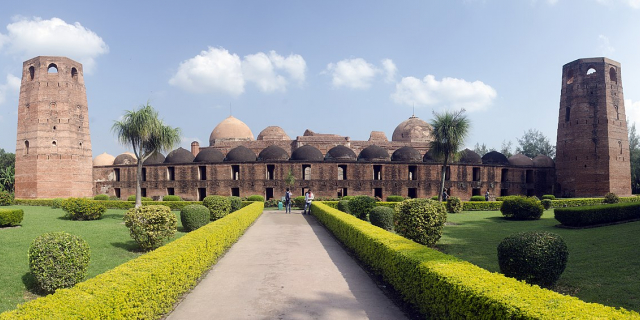Somapura Mahavihara
Somapura Mahavihara (Bengali: সোমপুর মহাবিহার, romanized: Shompur Môhabihar) or Paharpur Buddhist Vihara (Bengali: পাহাড়পুর বৌদ্ধ বিহার, romanized: Pāhāṛpur baud'dha bihār) in Paharpur, Badalgachhi, Naogaon, Bangladesh is among the best known Buddhist viharas or monasteries in the Indian Subcontinent and is one of the most important archaeological sites in the country. It was designated as a UNESCO World Heritage Site in 1985. It is one of the most famous examples of architecture in pre-Islamic Bangladesh. It dates from a period to the nearby Halud Vihara and to the Sitakot Vihara in Nawabganj Upazila of Dinajpur District.

A number of monasteries grew up during the Pāla period in ancient India in the eastern regions of the Indian subcontinent, comprising Bengal and Magadha. According to Tibetan sources, five great Mahaviharas (universities) stood out: Vikramashila, the premier university of the era; Nalanda, past its prime but still illustrious; Somapura Mahavihara; Odantapurā; and Jaggadala.[1] The mahaviharas formed a network; "all of them were under state supervision" and there existed "a system of co-ordination among them ... it seems from the evidence that the different seats of Buddhist learning that functioned in eastern India under the Pāla were regarded together as forming a network, an interlinked group of institutions," and it was common for great scholars to move easily from position to position among them.[2] Atisa, who resided at the Somapura Mahavihara (the largest university in ancient India at that time), traveled from Bengal to Tibet to preach Buddhism. The earliest form of the Bengali language began to the emerge during the eighth century.
The excavation at Paharpur, and the finding of seals bearing the inscription Shri-Somapure-Shri-Dharmapaladeva-Mahavihariyarya-bhiksu-sangghasya, has identified the Somapura Mahavihara as built by the second Pala king Dharmapala (circa 781–821) of Pāla Dynasty.[3] Tibetan sources, including Tibetan translations of Dharmakayavidhi and Madhyamaka Ratnapradipa, Taranatha's history and Pag-Sam-Jon-Zang, mention that Dharmapala's successor Devapala (circa 810–850) built it after his conquest of Varendra.[3] The Paharpur pillar inscription bears the mention of 5th regnal year of Devapala's successor Mahendrapala (circa 850–854) along with the name of Bhiksu Ajayagarbha.[3] Taranatha's Pag Sam Jon Zang records that the monastery was repaired during the reign of Mahipala (circa 995–1043 AD).[3]
Jatvarma of Varman dynasty attacked Varendra in 11th century with hostility towards Kaivarta king Divya and Buddhism. Though the Kaivarta regime did not seem to suffer any loss, a part of the Mahavihara was destroyed by fire set by Jatvarma's army.[4]
Over time Atisha's spiritual preceptor, Ratnakara Shanti, served as a sthavira of the vihara, Mahapanditacharya Bodhibhadra served as a resident monk, and other scholars spent part of their lives at the monastery, including Kalamahapada, Viryendra and Karunashrimitra.[3] Many Tibetan monks visited the Somapura between the 9th and 12th centuries.[3]
During the rule of the Sena dynasty in the second half of the 12th century the vihara started to decline for the last time.[3] One scholar writes, "The ruins of the temple and monasteries at Pāhāpur do not bear any evident marks of large-scale destruction. The downfall of the establishment, by desertion or destruction, must have been sometime in the midst of the widespread unrest and displacement of population consequent on the Muslim invasion."[5]
A copperplate dated to 159 Gupta Era (479 AD) discovered in 1927 in the northeast corner of the monastery, mentions donation of a Brahmin couple to Jain Acharya Guhanandi of Pancha-stupa Nikaya[6] at Vata Gohli, identifiable as the neighbouring village of Goalapara.[7]






























Add new comment